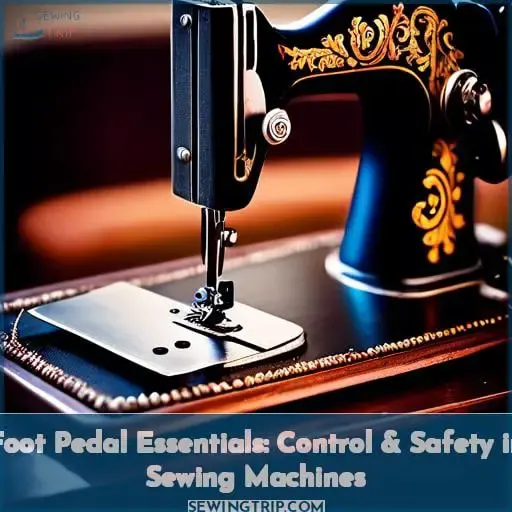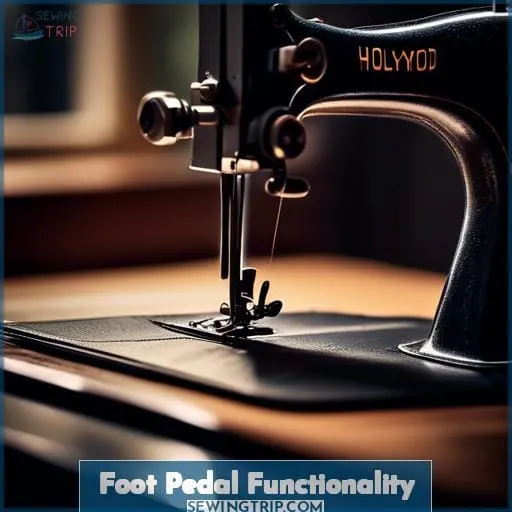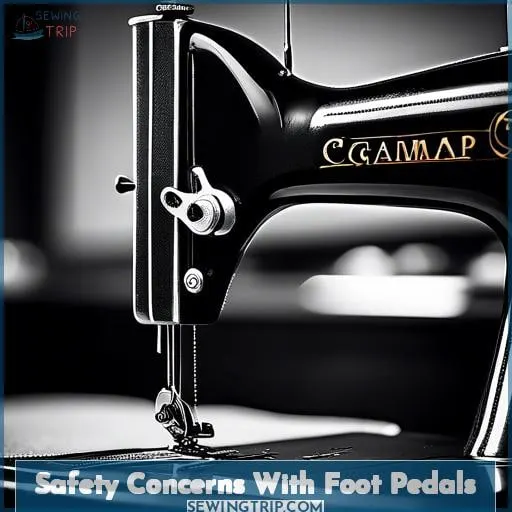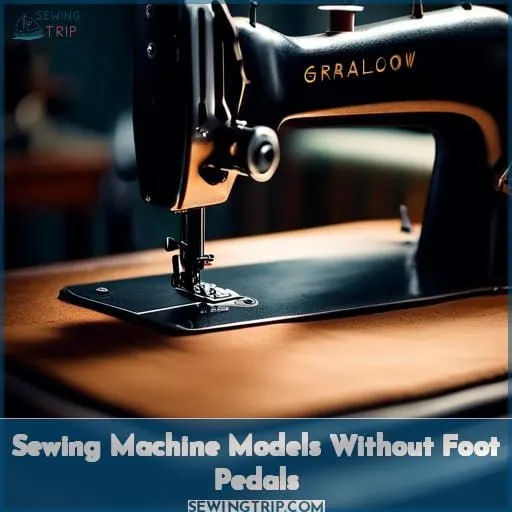This site is supported by our readers. We may earn a commission, at no cost to you, if you purchase through links.
 Stepping down, speeding up, slowing to a halt—your foot pedal is the unsung hero of sewing, granting you the power to masterfully manipulate your machine’s pace.
Stepping down, speeding up, slowing to a halt—your foot pedal is the unsung hero of sewing, granting you the power to masterfully manipulate your machine’s pace.
As you embark on your sewing journey, understanding the essentials of foot pedal control and safety is crucial. This guide will delve into the pivotal role of the foot pedal, explore alternatives for those who seek or require different options, and address safety concerns to ensure your sewing experience is both enjoyable and secure.
Embrace control over your creations and sew with confidence, knowing the foot pedal is more than just a tool; it’s your gateway to precision and artistry.
Table Of Contents
Key Takeaways
- The foot pedal on a sewing machine controls the speed and starts/stops the sewing process, which is crucial for precision and artistic sewing techniques.
- Alternatives to foot pedals, such as start/stop buttons and speed sliders, offer convenience and cater to individuals with disabilities or injuries.
- Sewing without a foot pedal can provide freedom of leg movement, cost savings on pedal replacements, and is suitable for those with mobility issues or ergonomic preferences.
- Safety concerns with foot pedals include the risk of overheating and fire, especially with vintage models, and the importance of using LED alternatives and checking cords and adapters for safe operation.
What Does the Foot Pedal Do on a Sewing Machine

Yes, the foot pedal on a sewing machine controls the machine’s speed and operation. By pressing the pedal, you regulate the sewing speed; a light press for slow stitching and fully depressed for maximum speed.
Foot Pedal Functionality
You rely on your sewing machine’s foot pedal to control the speed and manage the start and stop of your sewing projects.
If you’re considering alternatives, you’ll find that modern machines offer various options for pedal-free operation.
Speed Control
In the world of sewing, mastering the art of speed control can feel like trying to tame a wild horse. But fear not, because ditching the foot pedal can actually put you in the driver’s seat, giving you the precision of a skilled jockey.
Imagine free motion quilting or embroidery without the dance of foot coordination, allowing your creativity to flow as smoothly as a river. Slow sewing becomes a breeze, letting you navigate curves and appliqués with the grace of a ballet dancer.
And for those who fancy standing while sewing or simply want to stretch their legs, it’s like hitting the jackpot. Plus, think of the cost savings—no more shelling out big bucks for a foot pedal replacement.
Whether you’re eyeing a Janome or Brother machine, from budget-friendly to high-end, there’s a steed ready for you to mount, no foot pedal required. So saddle up and take control, because in the realm of sewing, you’re the one holding the reins.
Starting and Stopping Sewing
When you’re at the helm of your sewing machine, the foot pedal is your go-to for kicking off and wrapping up your stitching spree. It’s like the gas pedal in your car—press down to rev up, ease off to hit the brakes.
But if it’s acting up, don’t sweat it! Dive into foot pedal troubleshooting, check compatibility, and keep it in tip-top shape with regular maintenance. Stash it properly to avoid any fire hazards, and remember, LED light bulbs are your best bet for a cool, calm sewing experience.
Alternatives to Using a Foot Pedal
When exploring alternatives to using a foot pedal on a sewing machine, it’s essential to understand the benefits and options available.
Sewing machines equipped with a start/stop button and a speed slider offer a convenient and adaptable sewing experience, allowing for more control and flexibility in your projects. These features not only cater to those who may have difficulty using a traditional foot pedal due to disabilities or injuries but also provide advantages such as constant sewing speed and the ability to sew in various positions, including standing up.
The Janome and Brother sewing machine models mentioned offer a range of options for those interested in pedal-less sewing, from budget-friendly to high-end machines, ensuring that there’s a suitable choice for every sewer’s needs and preferences.
Start/Stop Button
Transitioning from traditional foot pedal control to the innovative start/stop button on your sewing machine opens up a new world of convenience and ergonomic benefits.
This button, designed for ease and efficiency, allows you to sew without the constant foot pedal dance, offering a solution that’s both safe and accommodating for various physical needs.
With the start/stop button, you gain precise control over your sewing projects, ensuring consistent speed that’s crucial for intricate work like free motion quilting or embroidery.
It’s a game-changer for those who face challenges with pedal placement due to mobility issues or for those who simply prefer the ergonomic design that caters to finger dexterity.
This feature not only enhances safety by eliminating the risk of pedal-related accidents but also promotes a more comfortable sewing experience, allowing you to focus on creativity without the physical strain.
Embrace the start/stop button for a seamless transition to more accessible, enjoyable sewing sessions.
Speed Slider for Control
Continuing from the convenience of a start/stop button,
let’s shift gears to the speed slider—a real game-changer for your sewing projects.
Imagine having the reins of your sewing machine’s speed, steering your stitches with the precision of a seasoned jockey.
With a speed slider, you’re the boss, setting the pace from a tortoise crawl for intricate applique work to a hare’s sprint for long, straight seams.
It’s like having cruise control for your sewing machine, ensuring your freehand embroidery and slow sewing are as smooth as silk.
No more pedal-to-the-metal moments that send your fabric flying; just cool, calm, collected stitching at your chosen tempo.
Say goodbye to foot pedal fiascos and hello to stress-free sewing.
Benefits of Sewing Without a Foot Pedal
Transitioning from the speed slider’s nuanced control, let’s dive into the world of sewing without a foot pedal.
Imagine the freedom of leg movement, stretching, or even standing while you stitch—sounds liberating, right? Plus, think of the cost savings; no more shelling out for a pricey pedal replacement.
For those eyeing Janome or Brother machines, options range from budget-friendly to high-end, ensuring there’s a perfect match for every sewer.
And for the vintage enthusiasts wrestling with a Singer 401A, going pedal-less might just be the modern twist your sewing practice needs.
Safety Concerns With Foot Pedals
You need to be aware that foot pedals on sewing machines, especially vintage models, can pose overheating and fire risks.
To prevent such hazards, it’s crucial to take certain measures.
Overheating and Fire Risks
Beware the heat! Your trusty foot pedal can turn into a fire starter if it’s from a vintage machine.
Swap out those old resistors for modern safety upgrades. Consider foot pedal replacements or LED alternatives to keep your creative flow cool and your workspace safe.
Preventive Measures
To keep your sewing sessions safe and your vintage machine humming, it’s crucial to stay on top of foot pedal maintenance.
Always check your power cord for frays or kinks that scream fire hazard. Ensure your adapter’s compatibility; a mismatch is like trying to fit a square peg in a round hole—frustrating and futile.
If you’re reviving an old pedal, treat it like a classic car—handle with care and respect its quirks. And remember, a safety switch isn’t just a nice-to-have; it’s your best bud in preventing a shocking experience.
Keep these tips in your back pocket, and you’ll be stitching up a storm without any shocking surprises.
Sewing Machine Models Without Foot Pedals
When considering sewing machine models that don’t require a foot pedal, it’s essential to know your options.
Janome and Brother offer a range of machines that cater to different budgets and needs, allowing for a more accessible and versatile sewing experience.
Janome Options
If you’re looking to dive into the world of sewing without being tied down by a foot pedal, Janome’s got your back with a lineup that caters to all budgets and needs. For those watching their wallet, the 230DC or CXL301 won’t break the bank. Mid-range mavens can stitch in style with the DXL603 or DSK30.
And for the sewing connoisseurs, the Atelier 5 or MC6600 are the high-end hotshots that’ll make your sewing space the envy of the crafty community.
These machines are a godsend for those who need to keep their footloose and fancy-free, whether due to ergonomic considerations or simply because you fancy a stretch mid-stitch. Plus, if you’re standing while sewing or working on a towering work surface, these pedal-less wonders are just the ticket.
And let’s not forget the repair and maintenance savings – no foot pedal means one less thing to fix or replace, keeping more pennies in your piggy bank.
Brother Options
When it comes to Brother sewing machines that let you kick the foot pedal to the curb, you’re in for a treat.
- Budget-Friendly Brilliance: Start with the Innov-is 15 or Innov-is A50 if you’re watching your wallet but still want a machine that’s a cut above the rest.
- Mid-Range Marvels: Step up to the Innov-is 420 or Innov-is F560 for a bit more oomph without breaking the bank.
- High-End Heroes: Go for the Innov-is 1800Q or Innov-is Vq2 if you’re ready to splurge on a machine that’s the cream of the crop.
These Brother models are a stitch above the rest when it comes to foot pedal replacement, maintenance, cost, durability, and compatibility. Say goodbye to the tap dance of sewing and hello to a smoother stitch with these savvy selections.
Adapting to Sewing Without a Foot Pedal
Adapting to sewing without a foot pedal can open up a world of possibilities, especially for individuals with disabilities or those who prefer standing while sewing.
This approach not only accommodates various physical needs but also supports sewing on high work surfaces, enhancing comfort and flexibility in your sewing projects.
For Individuals With Disabilities
Adapting to sewing without a foot pedal? It’s a game-changer for those with disabilities. Imagine the freedom! Assistive technology and ergonomic adaptations, like hand controls, make sewing accessible and enjoyable.
Specialized machines cater to your unique needs, ensuring you’re not left on the sidelines.
| Feature | Benefit | Emotion |
|---|---|---|
| Hand Controls | Enhanced Accessibility | Empowerment |
| Ergonomic Design | Reduced Strain | Comfort |
| Specialized Machines | Customized Experience | Inclusion |
| Assistive Technology | Independence | Pride |
| Disability Accommodations | Barrier-Free Sewing | Joy |
Standing Sewing and High Work Surfaces
Sewing without a foot pedal opens up a world of ergonomic benefits and creative possibilities. For those who’ve ever felt chained to their sewing machine by the foot pedal, imagine the freedom of a setup that caters to your comfort and flexibility.
Standing desks and high work surfaces aren’t just for office workers; they’re a game-changer for sewists too. By ditching the foot pedal, you can embrace leg flexibility and posture improvements, ensuring your sewing marathon doesn’t turn into a backache saga.
Plus, ergonomic setups mean increased comfort, letting your creativity flow without the physical constraints. So, chuckle at the thought of being tied down by traditional sewing setups and step into a world where your sewing machine adapts to you, not the other way around.
Frequently Asked Questions (FAQs)
Can a foot pedal affect stitch quality?
Absolutely, a foot pedal can impact your stitch quality.
It’s your sewing machine’s gas pedal—too much or too little pressure, and you’re in for a bumpy ride with uneven stitches!
How to maintain a sewing machine pedal?
Maintaining your sewing machine pedal is like giving your car a tune-up; it keeps everything running smoothly.
Regularly check the pedal for dust and debris, and gently clean it with a soft brush or cloth.
Occasionally, lubricate moving parts if your manual recommends it. This simple care can make your sewing journey as smooth as silk.
Are foot pedal adapters brand-specific?
Yes, foot pedal adapters can be brand-specific. Different sewing machine brands and models may require unique connectors or electrical specifications. It’s crucial to match the adapter to your machine’s make and model for a perfect fit and safe operation.
Can a foot pedal be repaired at home?
Diving into the heart of DIY, repairing a sewing machine foot pedal at home is like threading a needle in the dark—challenging but not impossible.
With a sprinkle of patience and a dash of elbow grease, you can breathe new life into that silent pedal. Whether it’s a loose wire begging for a reunion or a rebellious resistor needing a stern soldering talk, your living room can transform into an operation table for the wounded foot soldier.
Just remember, every stitch in time saves nine, and in this case, potentially saves you from buying a new pedal. So, roll up your sleeves, because with the right YouTube tutorial or a detailed eHow guide, you’re about to become the surgeon your sewing machine never knew it needed.
What are common foot pedal connectivity issues?
You’re cruising along on your sewing project when suddenly, your foot pedal decides to play hide and seek with the power.
Common culprits? A sneaky broken cable, loose wires playing peek-a-boo, or a pedal stuck in a daydream.
Don’t let these gremlins slow your roll!
Conclusion
Mastering the foot pedal on your sewing machine is akin to taming a wild stallion—it’s the key to harnessing the full potential of your creative endeavors.
With the foot pedal, you’re in command, effortlessly dictating the speed and rhythm of your stitches. Whether you’re a seasoned pro or a newcomer, the foot pedal is your ally, ensuring your sewing machine dances to the beat of your project’s needs.
For those facing challenges with traditional foot pedals, modern machines offer alternatives like start/stop buttons and speed sliders, providing a seamless sewing experience that caters to everyone’s needs.










